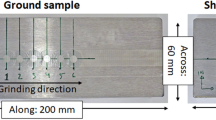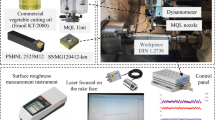Abstract
The heat generated and accumulated on the machined surface of an Inconel 718 workpiece causes thermal damage during the cutting process. Surface-active media with high thermal conductivity coated on the workpiece to be machined may have the potential to reduce the generation of cutting heat. In this study, a theoretical model for predicting the instantaneous machined surface temperature field is proposed for surface-active thermal conductive medium (SACM)-assisted cutting based on the finite element and Fourier heat transfer theories. Orthogonal cutting experiments were performed to verify the results predicted using the proposed surface-temperature field model. Three SACMs with various thermal conductivities were used to coat Inconel 718 surface to be machined. Thermocouples embedded into the workpiece were used to measure the cutting temperature at different points on the machined workpiece surface during the cutting process. The experimental results were in agreement with the predicted temperatures, and the maximum error between the experimental results and predicted temperatures was approximately 9.5%. The cutting temperature on the machined surface decreased with an increase in the thermal conductivity of the SACM. The graphene SACM with high thermal conductivity can effectively reduce the temperature from 542 °C to 402 °C, which corresponds to a reduction of approximately 26%. The temperature reduction due to SACM decreases with an increase in the distance between the temperature prediction point and machined workpiece surface. In conclusion, the cutting temperatures on the machined workpiece surface can be reduced by coating with SACM.













Similar content being viewed by others
References
Bartolomeis AD, Newman ST, Jawahir IS et al (2021) Future research directions in the machining of Inconel 718. J Mater Process Technol 297:117260. https://doi.org/10.1016/j.jmatprotec.2021.117260
Kadam GS, Pawade RS (2017) Surface integrity and sustainability assessment in high-speed machining of Inconel 718—an eco-friendly green approach. J Clean Prod 147:273–283
Zhang Y, Li HN, Li C et al (2022) Nano-enhanced biolubricant in sustainable manufacturing: from processability to mechanisms. Friction 10:803–841
Thakur A, Gangopadhyay S (2016) State-of-the-art in surface integrity in machining of nickel-based super alloys. Int J Mach Tools Manuf 100:25–54
Yang M, Li C, Zhang Y et al (2019) Predictive model for minimum chip thickness and size effect in single diamond grain grinding of zirconia ceramics under different lubricating conditions. Ceram Int 45:14908–14920
Aurich JC, Zimmermann M, Schindler S et al (2016) Turning of aluminum metal matrix composites: influence of the reinforcement and the cutting condition on the surface layer of the workpiece. Adv Manuf 4:225–236
Uçak N, Çiçek A (2018) The effects of cutting conditions on cutting temperature and hole quality in drilling of Inconel 718 using solid carbide drills. J Manuf Process 31:662–673
Zhao YX, Guo K, Sivalingam V et al (2021) Surface integrity evolution of machined NiTi shape memory alloys after turning process. Adv Manuf 9:446–456
Chaudhari A, Soh ZY, Wang H et al (2018) Rehbinder effect in ultraprecision machining of ductile materials. Int J Mach Tools Manuf 133:47–60
Yin Q, Liu Z, Wang B (2021) Machinability improvement of Inconel 718 through mechanochemical and heat transfer effects of coated surface-active thermal conductive mediums. J Alloys Compd 876:160186. https://doi.org/10.1016/j.jallcom.2021.160186
Yang M, Li C, Zhang Y et al (2019) Effect of friction coefficient on chip thickness models in ductile-regime grinding of zirconia ceramics. Int J Adv Manuf Technol 102:2617–2632
Komanduri R, Hou ZB (2001) Thermal modeling of the metal cutting process—part III: temperature rise distribution due to the combined effects of shear plane heat source and the tool-chip interface frictional heat source. Int J Mech Sci 43:89–107
Huang K, Yang W (2016) Analytical model of temperature field in workpiece machined surface layer in orthogonal cutting. J Mater Process Technol 229:375–389
Feng Y, Pan Z, Liang SY (2018) Temperature prediction in Inconel 718 milling with microstructure evolution. Int J Adv Manuf Technol 95:4607–4621
Xia Q, Gillespie DRH (2020) Quasi-static finite element modelling of thermal distribution and heat partitioning for the multi-component system of high speed metal cutting. J Mater Process Technol 275:116389. https://doi.org/10.1016/j.jmatprotec.2019.116389
Yin W, Duan C, Sun W et al (2020) Analytical model of cutting temperature for workpiece surface layer during orthogonal cutting particle reinforced metal matrix composites. J Mater Process Technol 282:116643. https://doi.org/10.1016/j.jmatprotec.2020.116643
Guo XG, Li M, Dong ZG et al (2019) Smooth particle hydrodynamics modeling of cutting force in milling process of TC4. Adv Manuf 7:364–373
Xie HB, Yang ZQ, Qin N et al (2020) Strain rate analyses during elliptical vibration cutting of Inconel 718 using finite element analysis, Taguchi method, and ANOVA. Adv Manuf 8:316–330
Li C, Piao Y, Hu Y et al (2021) Modelling and experimental investigation of temperature field during fly-cutting of KDP crystals. Int J Mech Sci 210:106751. https://doi.org/10.1016/j.ijmecsci.2021.106751
Yang M, Li C, Zhang Y et al (2017) Research on microscale skull grinding temperature field under different cooling conditions. Appl Therm Eng 126:525–537
Jiang X, Kong X, He S et al (2021) Modeling the superposition of residual stresses induced by cutting force and heat during the milling of thin-walled parts. J Manuf Process 68:356–370
Yin Q, Li C, Dong L et al (2021) Effects of physicochemical properties of different base oils on friction coefficient and surface roughness in MQL milling AISI 1045. Int J Precis Eng Manuf Green Technol 8:1629–1647
Moghanlou FS, Vajdi M, Sha J et al (2019) A numerical approach to the heat transfer in monolithic and SiC reinforced HfB2, ZrB2 and TiB2 ceramic cutting tools. Ceram Int 45:15892–15897
Santos JA, Oliveira JRF, do Nascimento JG et al (2022) Simultaneous estimation of thermal properties via measurements using one active heating surface and Bayesian inference. Int J Therm Sci 172:107304. https://doi.org/10.1016/j.ijthermalsci.2021.107304
Yan C, Wei D, Wang G (2022) Three-dimensional finite discrete element-based contact heat transfer model considering thermal cracking in continuous–discontinuous media. Comput Methods Appl Mech Eng 388:114228. https://doi.org/10.1016/j.cma.2021.114228
Yin Q, Liu Z, Li X et al (2022) Heat transfer enhancement with surface-active thermal conductive media coating during orthogonal cutting Inconel 718. Int J Adv Manuf Technol 120:5823–5833
Peng R, He X, Tong J et al (2021) Application of a tailored eco-friendly nanofluid in pressurized internal-cooling grinding of Inconel 718. J Clean Prod 278:123498. https://doi.org/10.1016/j.jclepro.2020.123498
Chinkanjanarot S, Tomasi JM, King JA et al (2018) Thermal conductivity of graphene nanoplatelet/cycloaliphatic epoxy composites: multiscale modeling. Carbon N Y 140:653–663
Zhao J, Liu Z, Wang B et al (2020) PVD AlTiN coating effects on tool-chip heat partition coefficient and cutting temperature rise in orthogonal cutting Inconel 718. Int J Heat Mass Transf 163:120449. https://doi.org/10.1016/j.ijheatmasstransfer.2020.120449
Chaudhari A, Wang H (2019) Effect of surface-active media on chip formation in micromachining. J Mater Process Technol 271:325–335
Salur E (2022) Understandings the tribological mechanism of Inconel 718 alloy machined under different cooling/lubrication conditions. Tribol Int 174:107677. https://doi.org/10.1016/j.triboint.2022.107677
Ye RR, Li HY, Ding RG et al (2020) Microstructure and microhardness of dissimilar weldment of Ni-based superalloys IN718-IN713LC. Mater Sci Eng A 774:138894. https://doi.org/10.1016/j.msea.2019.138894
Iturbe A, Giraud E, Hormaetxe E et al (2017) Mechanical characterization and modelling of Inconel 718 material behavior for machining process assessment. Mater Sci Eng A 682:441–453
Sifi O, Djeghlal MEA, Mebdoua Y et al (2020) The effect of the solution and aging treatments on the microstructures and microhardness of nickel-based superalloy. Appl Phys A Mater Sci Process 126:1–11
Liu JH, Yan JX, Liu YD et al (2021) Impact of annealing temperature on the microstructure, microhardness, tribological properties and corrosion resistance of Ni–Mo/diamond composites. Appl Surf Sci 541:148367. https://doi.org/10.1016/j.apsusc.2020.148367
Acknowledgements
The authors acknowledge the financial support from the National Key Research and Development Program of China (Grant No. 2019YFB2005401). This work was also supported by grants from the National Natural Science Foundation of China (Grant No. 91860207) and Taishan Scholar Foundation.
Author information
Authors and Affiliations
Corresponding author
Rights and permissions
Springer Nature or its licensor (e.g. a society or other partner) holds exclusive rights to this article under a publishing agreement with the author(s) or other rightsholder(s); author self-archiving of the accepted manuscript version of this article is solely governed by the terms of such publishing agreement and applicable law.
About this article
Cite this article
Yin, QA., Liu, ZQ. & Wang, B. Prediction of temperature field in machined workpiece surface during the cutting of Inconel 718 coated with surface-active media. Adv. Manuf. 11, 378–389 (2023). https://doi.org/10.1007/s40436-023-00445-1
Received:
Revised:
Accepted:
Published:
Issue Date:
DOI: https://doi.org/10.1007/s40436-023-00445-1




